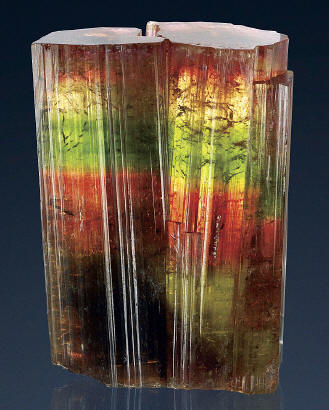
Ajoined crystals of liddicoatite with strong color zonation, 5.5 cm in length. A. Watzl Jr. specimen and photo.
By September 2012 the number ofminers had dropped to about 50 andthereafter gradually declined to the 25-30 miners who currently work themine (May 2013). Further productionfrom this area will be hampered byground water inflow into the pits whichmakes the use of primitive mining methodsimpractical.
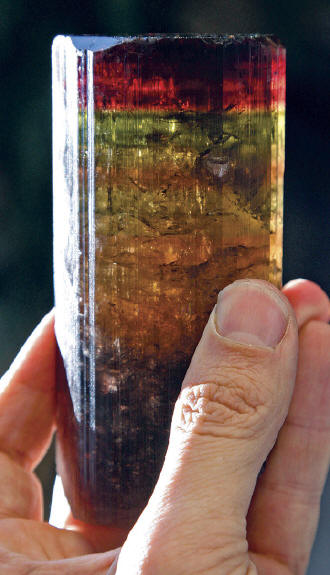
Multi-color liddicoatite crystal, weight 800g F. Pezzotta photo.

One of the big multi-color liddicoatite crystals, 11.4 cm in length. M. Oleszczuk collection. J. Gajowniczek photo.
The lack of surface exposures, andthe poor exposures at depth in the pits,make it difficult for geologists to developa model for extending this productivezone. Therefore, the
future potential ofthis place remains unknown.
MINERALOGY
The mineralogy of this pegmatiteseems to be very simple, and the mineralsfound in the pockets are the sameminerals which compose the coarse grained pegmatitic rock. The followingminerals are present: milky white to palequartz var. citrine, microcline (more orless corroded to spongy aggregates),albite variety clevelandite, “lepidolite” inlarge blades, tourmaline ranging in colorfrom dark green-brown at the core ofthe base to multicolored, and deeplycorroded large crystals of danburite.

Big cluster of liddicoatite crystals showing strong color zonation when backlighted, 13 cm in length. Watzl Minerals specimen. A. Watzl Sr. photo.
Rarely, small octahedral crystals of apyrochlore-group mineral have beenobserved both frozen in the rock and asinclusions at the base of tourmaline crystals.
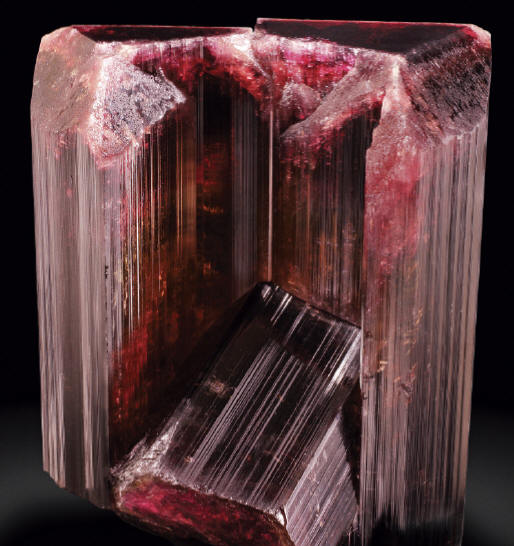
Same cluster as shown in the photo on the left revealing a differnt color when backlit from a different angle. Watzl Minerals specimen. J. Callén photo.
Estatoby tourmalines are impressivefor their size, sharpness, andexceptionally complex color zoning. Thecrystals are typically very glassy andtransparent but the largest
crystals,because of their size, can be fully appreciatedonly with strong backlight.
From a study of the specimens producedit is clear that at least two largebut different cavities (likely close to oneanother) were encountered. Two typesof crystal morphology and two types ofcolor zoning are present: the first type,which appears in the first Pieró find, ischaracterized by a large pedion face atthe termination, modified on the sides bysmall
faces of trigonal pyramid, and by adeeply red growth sector of limited thicknessat the termination; the second typeis characterized by dominating pyramidalfaces at the termination,
with a smalltriangular pedion face at the top, and bya much thicker deeply red growth sectorat the termination. Crystals of the secondtype are in general less elongated. Itis
important to note that, in both cases,the termination corresponds to the antilogouspole of the crystals.
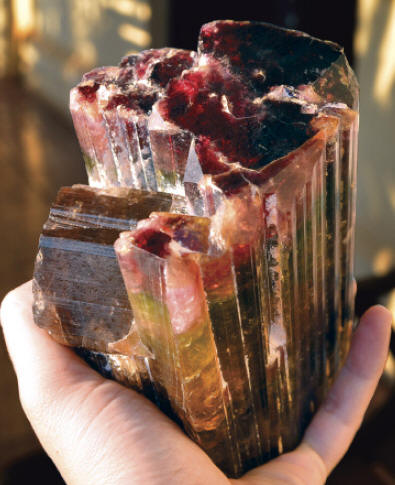
Simillar specimen photograhed when still dirty shortly after it was collected. J. Gajowniczek photo.
Three different sectors can be distinguishedin the largest complete crystals.
Each sector includes about onethird of the length of the crystal.
When the lower sector is viewedthrough the prism faces, it appears to bedark reddish-brownish in color, and ischaracterized by a zoning developedboth across the c axis and in the directionof complex and steep terminationfaces. This sector is typically suitable forcutting nice zoned slices, which have alarge vivid red core with a centereddarker triangle,
surrounded by a multicoloredthick sector with numerousgrowth zones of green, yellow, pink, andred.
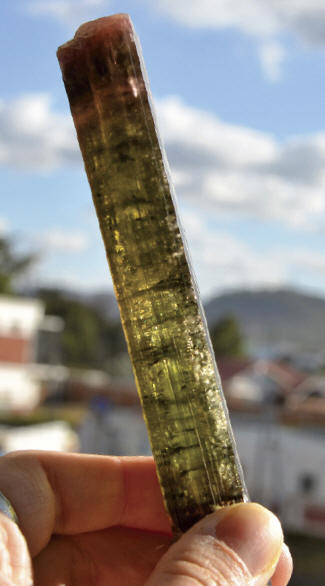
Elongated liddicoatite crystal from one of the side pockets showing different colors and habit, 11.4 cm in length. M. Oleszczuk collection. J. Gajowniczek photo.
The intermediate sector is a ratherhomogenous vivid green to yellow-green color, and represents a growth zone developed mostly in the direction of the c axis.









 YueGongAnBei 44051102000467
YueGongAnBei 44051102000467


 |
|